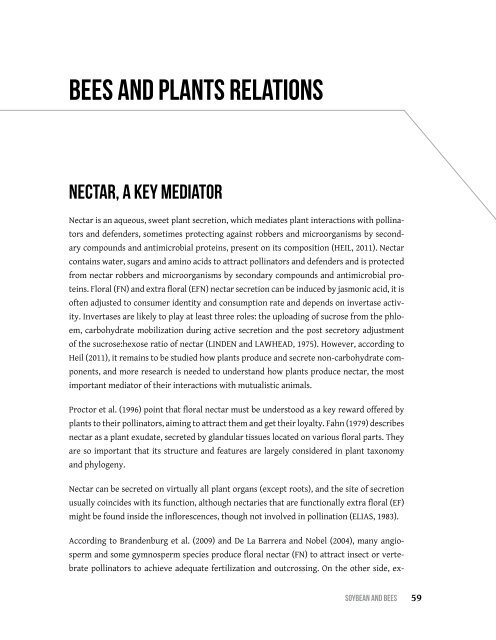Soybean and Bees
Create successful ePaper yourself
Turn your PDF publications into a flip-book with our unique Google optimized e-Paper software.
<strong>Bees</strong> <strong>and</strong> plants relations<br />
Nectar, a key mediator<br />
Nectar is an aqueous, sweet plant secretion, which mediates plant interactions with pollinators<br />
<strong>and</strong> defenders, sometimes protecting against robbers <strong>and</strong> microorganisms by secondary<br />
compounds <strong>and</strong> antimicrobial proteins, present on its composition (Heil, 2011). Nectar<br />
contains water, sugars <strong>and</strong> amino acids to attract pollinators <strong>and</strong> defenders <strong>and</strong> is protected<br />
from nectar robbers <strong>and</strong> microorganisms by secondary compounds <strong>and</strong> antimicrobial proteins.<br />
Floral (FN) <strong>and</strong> extra floral (EFN) nectar secretion can be induced by jasmonic acid, it is<br />
often adjusted to consumer identity <strong>and</strong> consumption rate <strong>and</strong> depends on invertase activity.<br />
Invertases are likely to play at least three roles: the uploading of sucrose from the phloem,<br />
carbohydrate mobilization during active secretion <strong>and</strong> the post secretory adjustment<br />
of the sucrose:hexose ratio of nectar (LINDEN <strong>and</strong> LAWHEAD, 1975). However, according to<br />
Heil (2011), it remains to be studied how plants produce <strong>and</strong> secrete non-carbohydrate components,<br />
<strong>and</strong> more research is needed to underst<strong>and</strong> how plants produce nectar, the most<br />
important mediator of their interactions with mutualistic animals.<br />
Proctor et al. (1996) point that floral nectar must be understood as a key reward offered by<br />
plants to their pollinators, aiming to attract them <strong>and</strong> get their loyalty. Fahn (1979) describes<br />
nectar as a plant exudate, secreted by gl<strong>and</strong>ular tissues located on various floral parts. They<br />
are so important that its structure <strong>and</strong> features are largely considered in plant taxonomy<br />
<strong>and</strong> phylogeny.<br />
Nectar can be secreted on virtually all plant organs (except roots), <strong>and</strong> the site of secretion<br />
usually coincides with its function, although nectaries that are functionally extra floral (EF)<br />
might be found inside the inflorescences, though not involved in pollination (Elias, 1983).<br />
According to Br<strong>and</strong>enburg et al. (2009) <strong>and</strong> De La Barrera <strong>and</strong> Nobel (2004), many angiosperm<br />
<strong>and</strong> some gymnosperm species produce floral nectar (FN) to attract insect or vertebrate<br />
pollinators to achieve adequate fertilization <strong>and</strong> outcrossing. On the other side, ex-<br />
SoybeAn <strong>and</strong> bees<br />
59


